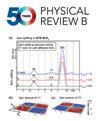Spectral function of a bipolaron coupled to dispersive optical phonons
IF 3.7
2区 物理与天体物理
Q1 Physics and Astronomy
引用次数: 0
Abstract
Using an efficient variational exact diagonalization method, we computed the electron removal spectral function within the framework of the Holstein-Hubbard model containing two electrons with opposite spins coupled to dispersive quantum optical phonons. We focus on how the interplay between the electron-phonon coupling and on-site Coulomb repulsion shapes the spectral function, a quantity directly relevant to angle-resolved photoemission spectroscopy (ARPES). Tuning the strengths of the electron-phonon coupling and the Hubbard interaction allows us to examine the evolution of the spectral properties of the system as it crosses over from a bound bipolaron to separate polarons. We find that phonon dispersion plays an important role: It substantially redistributes the spectral weight across the low- and the high-energy features and controls the emergence and the structure of distinct multiphonon continua. In regimes of strong electron-phonon coupling and low Coulomb repulsion, the spectral function exhibits a broad distribution reflecting bound bipolaronic states. Increasing the Coulomb repulsion weakens bipolaron binding, shifts the primary quasiparticle peak closer to polaronic behavior and confines the spectral weight near the Brillouin-zone center. Our results provide a framework for interpreting ARPES measurements in systems where phonon–mediated attraction competes with direct Coulomb repulsion.求助全文
约1分钟内获得全文
求助全文
来源期刊

Physical Review B
物理-物理:凝聚态物理
CiteScore
6.70
自引率
32.40%
发文量
0
审稿时长
3.0 months
期刊介绍:
Physical Review B (PRB) is the world’s largest dedicated physics journal, publishing approximately 100 new, high-quality papers each week. The most highly cited journal in condensed matter physics, PRB provides outstanding depth and breadth of coverage, combined with unrivaled context and background for ongoing research by scientists worldwide.
PRB covers the full range of condensed matter, materials physics, and related subfields, including:
-Structure and phase transitions
-Ferroelectrics and multiferroics
-Disordered systems and alloys
-Magnetism
-Superconductivity
-Electronic structure, photonics, and metamaterials
-Semiconductors and mesoscopic systems
-Surfaces, nanoscience, and two-dimensional materials
-Topological states of matter
 求助内容:
求助内容: 应助结果提醒方式:
应助结果提醒方式:


